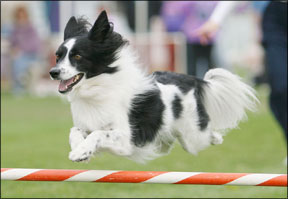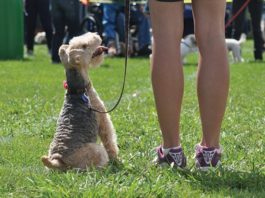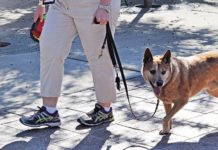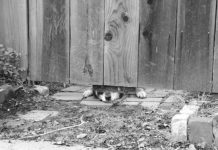How to Help a Leash-Reactive Dog
Beyond the human hang-ups and logistical challenges associated with a dog who now displays reactive behavior in the presence of other dogs, we must consider the impact on the dog. Reactive outbursts are the product of distress, and distress is serious business. It takes a long time for the body to recover from the jolt of hormones that happens during a distressful event. This altered brain state can leave your dog susceptible to triggers he might not otherwise react to, which is why many dogs can seem edgy" for some time following a particularly stressful event."
Frustrated On Leash?
You’ve probably seen them. Maybe you even have one – a dog who happily plays with his canine pals in the dog park, but...
Living with a Difficult Dog
By your own standards, your dog’s life may not seem all that stressful – after all, he doesn’t have bills to pay, does he? But when you apply the more scientific definition of the word – anything that alarms or excites him, triggering his sympathetic nervous system into action and flooding him with the “fight or flight” chemicals adrenaline and noradrenaline – you may be able to see how many seemingly unrelated things in his environment actually contribute to his “misbehavior.”
Be Cautious While Tying Your Dog in the Backyard
I was trying to be a responsible dog owner. We lived in a rural area of Northern California, in a house with no fenced yard. My boyfriend's Irish Setter had recently been shot and killed while chasing a neighbor's goats. A hard lesson to learn, and one I wasn't about to repeat. So when we were leaving the ranch for a day I insisted we tie up our recently acquired St. Bernard, Bear. We tied him to a tree, made sure he had access to plenty of water and shade and was nowhere near a fence that he could climb over. Confident that we had done the right thing, we drove off.
Pros and Cons of Electric Underground Fences
Electronic fences and their partners collars that deliver an aversive agent have been around for more than 20 years. They seem like the perfect canine confinement alternative to a solid physical fence. They are often marketed as the ideal fencing solution to homeowner association fence prohibitions and for problematic, difficult-to-fence, steep, rocky and rugged living spaces. But while occurrences of a collar shorting out and administering repeated shocks to a hapless, helpless dog are relatively rare, there are other drawbacks to using electronic fencing systems. A conscientious owner will weigh all the pros and cons before deciding whether or not to invest in this sort of fencing" system. "
Some Quick Tips for Loose Leash Walking
Joan Morse, CPDT-KA, CA-P1, CNWI, of Tailwaggers Canine Campus in Newark, Delaware, recommends Leslie McDevitt’s “Pattern Games” when teaching loose-leash walking. She describes one of those games: “The Two Step: drop a treat on the ground. Take two steps forward while the dog eats the treat. The moment he looks up at you, click, drop another treat right by you and take two more steps. This game develops a pattern or rhythm for the dog that will keep his attention on the handler and keep him moving as she moves. You usually get a nice loose leash walk quickly.”
Why (and How) Dogs Escape Fences
The risks for a free-roaming dog are legion, including, but not limited to: getting hit by a car, shot by an irate neighbor or a police officer protecting public safety, attacking or being attacked by other animals, being picked up by animal control, or simply vanishing, never to be seen again. Yet some dogs seem hell-bent on escaping doing everything they can think of to get over, under, around, or through their humans' containment strategies. What do you do when you have a dog who is dedicated to escaping his yard?
Electric Dog Fences: Are They Safe?
One rainy day afternoon that week, upon arriving home, Darren Ashby, an electronic engineer, sent his oldest son out to the pen to take Rufus for a walk. The boy came back in and said Rufus wouldn't let the boy get near him. Dad went out to help, and was horrified by what he found. What I saw made me sick
Solve Fence Aggression with a Better Dog Fence
As dog owners become more and more responsible about keeping their dogs safe at home, the incidence of fence-related behavior problems rises. Even the unfortunately popular underground electronic (shock) containment system fences can give rise to the problem. The barrier is there, even if the dog can't see it, and the intense punishment of the shock the dog receives if he breaches the invisible barrier can intensify the resulting aggression.
Tips on Stopping a Loose Dog from Approaching You
Being approached by loose dogs, especially when my dogs are on leash, is my least-favorite experience as a dog owner. When we're walking in a public place, such as a beach or park, I can usually identify the owner and ask that he please wrangle his dog. Of course, this request may be met with varying responses, ranging from appropriately apologetic for their dog having invaded our space, to accusatory, suggesting I am the problem for not allowing my dogs to roam free and socialize. But as uncomfortable as it may be to deal with unpleasant dog owners, it can be even worse to deal with a loose dog whose owner is nowhere in sight!
Do Electric Shock Collars Harm Dogs?
Do you use an underground electric shock fence to contain your dog? Are you considering having one installed? I hope reading this will change your mind. More and more neighborhoods prohibit or limit the useof fencing, and as this occurs, the use of these non-visible electric shock perimeters has drastically increased. Manufacturers and retailers claim that these products are humane, effective means by which to safely confine dogs without disrupting the aesthetics of neighborhoods.
Unwanted Dog-Reactive Behaviors
Dog-reactive behavior can be alarming and frustrating for a dog owner, as well as damaging to the canine-human relationship. Most of us adopt our dogs with the hope of sharing them with the rest of the world – on walks, at family picnics, at events around town, and sometimes at canine competitions. It’s not quite as much fun when you have to leave your canine family member at home because he barks, leaps around, lunges at, maybe even tries to bite other dogs.















